
Alvarezsauridae is a family of small, long-legged dinosaurs. Although originally thought to represent the earliest known flightless birds, they are now thought to be an early diverging branch of maniraptoran theropods. Alvarezsaurids were highly specialized. They had tiny but stout forelimbs, with compact, bird-like hands. Their skeletons suggest that they had massive breast and arm muscles, possibly adapted for digging or tearing. They had long, tube-shaped snouts filled with tiny teeth. They have been interpreted as myrmecophagous, adapted to prey on colonial insects such as termites, with the short arms acting as effective digging instruments to break into nests.

The Enantiornithes, also known as enantiornithines or enantiornitheans in literature, are a group of extinct avialans, the most abundant and diverse group known from the Mesozoic era. Almost all retained teeth and clawed fingers on each wing, but otherwise looked much like modern birds externally. Over eighty species of Enantiornithes have been named, but some names represent only single bones, so it is likely that not all are valid. The Enantiornithes became extinct at the Cretaceous–Paleogene boundary, along with Hesperornithes and all other non-avian dinosaurs.
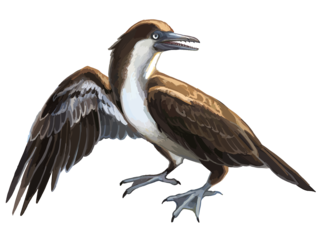
Yanornis is an extinct genus of fish-eating Early Cretaceous birds. Two species have been described, both from Liaoning province, China: Yanornis martini, based on several fossils found in the 120-million-year-old Jiufotang Formation at Chaoyang, and Yanornis guozhangi, from the 124-million-year-old Yixian Formation.

Archaeopterygidae is a group of paravian dinosaurs, known from the latest Jurassic and earliest Cretaceous of Europe. In most current classifications, it contains only the genera Archaeopteryx and Wellnhoferia. As its name suggests, Protarchaeopteryx was also once referred to this group, but most paleontologists now consider it an oviraptorosaur. Other referred genera, like Jurapteryx, Wellnhoferia, and "Proornis", are probably synonymous with Archaeopteryx or do not belong into this group. Jinfengopteryx was originally described as an archaeopterygid, though it was later shown to be a troodontid. A few studies have recovered Anchiornis and Xiaotingia to also be members of the Archaeopterygidae, though most subsequent analyses have failed to arrive at the same result. Uncertainties still exist, however, and it may not be possible to confidently state whether archaeopterygids are more closely related to modern birds or to deinonychosaurs barring new and better specimens of relevant species. Teeth attributable to archaeopterygids are known from the earliest Cretaceous (Berriasian) Cherves-de-Cognac locality and the Angeac-Charente bonebed of France.

Gansus is a genus of aquatic birds that lived during the Aptian age of the Early Cretaceous (Aptian-Albian) period in what are now Gansu and Liaoning provinces, western China. The rock layers from which their fossils have been recovered are dated to 120 million years ago. It was first described in 1984 on the basis of an isolated left leg. It is the oldest-known member of the Ornithurae, the group which includes modern birds (Neornithes) and extinct related groups, such as Ichthyornis and Hesperornithes.

Hongshanornis is a genus of ornithuromorph birds known from early Cretaceous lake deposits of the Yixian Formation, Inner Mongolia, China. The holotype specimen, recovered in 2005, is currently held by the Institute of Vertebrate Paleontology and Paleoanthropology in Beijing. It was found in the Jianshangou fossil beds, dated to 124.6 million years ago. Three additional specimens have been reported, though only one of those has been definitively identified as belonging to Hongshanornis. This latter specimen was found in the Dawangzhangzi fossil beds, which are about 122 million years old.
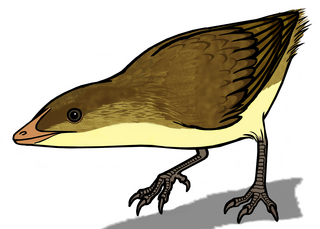
Eoalulavis is a monotypic genus of enantiornithean bird that lived during the Barremian, in the Lower Cretaceous around 125 million years ago. The only known species is Eoalulavis hoyasi.

Yixianornis is a bird genus from the early Cretaceous period. Its remains have been found in the Jiufotang Formation at Chaoyang dated to the early Aptian age, around 120 million years ago. Only one species, Yixianornis grabaui, is known at present. The specific name, grabaui, is named after American paleontologist Amadeus William Grabau, who surveyed China in the early 20th century.
Ambiortus is an extinct genus of ornithuromorph dinosaurs. The only known species, Ambiortus dementjevi, lived sometime during the Barremian age between 136.4 and 125 million years ago in the Andaikhudag Formation of Mongolia. It was discovered by Yevgeny Kurochkin in 1982.
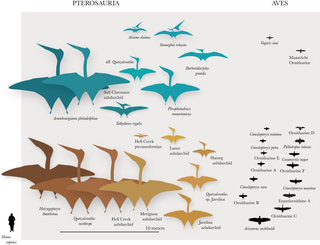
Palintropus is a prehistoric bird genus from the Late Cretaceous. A single species has been named based on a proximal coracoid from the Lance Formation of Wyoming, dated to the latest Maastrichtian, 66 million years ago. Coracoids and a proximal scapula of two unnamed species from the upper Campanian Dinosaur Park Formation of Alberta, dating to between 76.5 and 75 million years ago, are also known.
Limenavis is a prehistoric bird genus from the Late Cretaceous. It lived about 70 million years ago, around the Campanian-Maastrichtian boundary. Known from several broken bones, the remains of the only known species Limenavis patagonica were found in rocks of the "lower member" of the Allen Formation at Salitral Moreno, 20 km south of General Roca, Río Negro (Argentina). It is the closest relative, in the fossil record, of the modern birds.
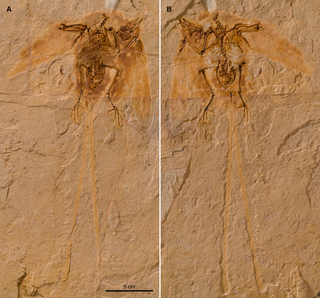
Ornithothoraces is a group of avialan dinosaurs that includes all enantiornithes and the euornithes, which includes modern birds and their closest ancestors. The name Ornithothoraces means "bird thoraxes". This refers to the modern, highly advanced anatomy of the thorax that gave the ornithothoracines superior flight capability compared with more primitive avialans. This anatomy includes a large, keeled breastbone, elongated coracoids and a modified glenoid joint in the shoulder, and a semi-rigid rib cage. In spite of this at least the sternum seems to have developed convergently rather than being a true homology.

Pygostylia is a group of avialans which includes the Confuciusornithidae and all of the more advanced species, the Ornithothoraces.

Protopteryx is an extinct bird and possibly the basalmost enantiornithean, from the Cretaceous period. The type species is P. fengningensis. It was first discovered in the Sichakou Member of the Yixian Formation or Huajiying Formation of Hebei Province, northern China, dating from 131 Ma ago. Protopteryx has been found in the Daibeigou formation, as well. The name Protopteryx means "primitive feather": "proto-" meaning "the first of" and "-pteryx" meaning "feather" or "wing." The name comes from the fact that Protopteryx feathers are more primitive than those of modern birds, such as the two elongated tail feathers that lack barbs and rami.
Zhongornis is a genus of primitive maniraptoran dinosaurs that lived during the Early Cretaceous. It was found in rocks of the Yixian Formation in Lingyuan City (China), and described by Gao et al. in 2008.

Songlingornithidae is a family of basal euornithean dinosaurs from the Early Cretaceous of China. All known specimens come from the Jiufotang Formation and the Yixian Formation, dating to the early Barremian and Aptian ages, 125–120 million years ago.
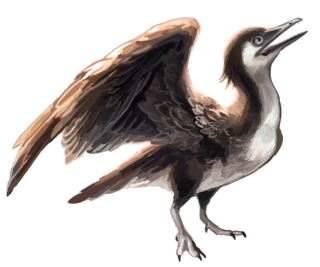
Yanornithiformes is an order of ornithuromorph dinosaurs from the early Cretaceous Period of China. All known specimens come from the Yixian Formation and Jiufotang Formation, dating to the early Aptian age, 124.6 to 120 million years ago.

Euornithes is a natural group which includes the most recent common ancestor of all avialans closer to modern birds than to Sinornis.

Luis María Chiappe is an Argentine paleontologist born in Buenos Aires who is best known for his discovery of the first sauropod nesting sites in the badlands of Patagonia in 1997 and for his work on the origin and early evolution of Mesozoic birds. He is currently the Vice President of Research and Collections at the Natural History Museum of Los Angeles County and director of the museum's Dinosaur Institute. He was a postdoctoral researcher at the American Museum of Natural History, New York after immigrating from Argentina. Chiappe is currently the curator of the award winning Dinosaur Hall at the Natural History Museum of Los Angeles County, an adjunct professor at the University of Southern California, BBC advisor and author of scientific and popular books.























